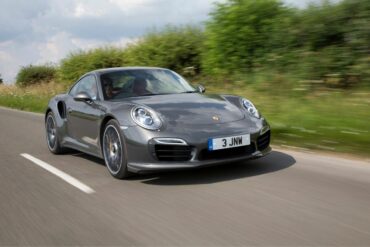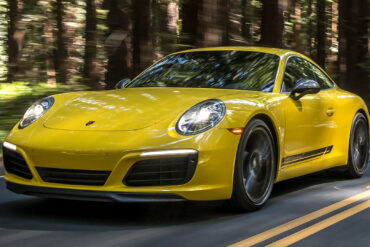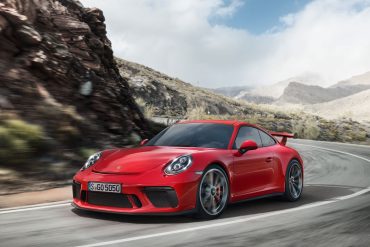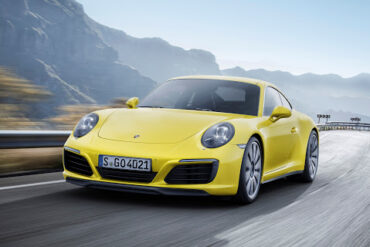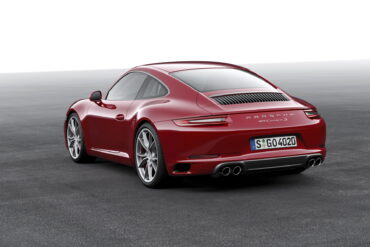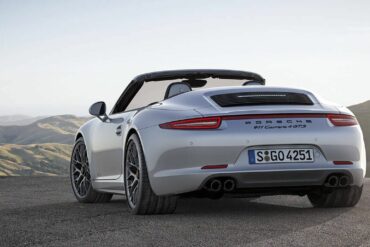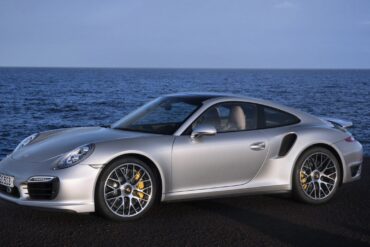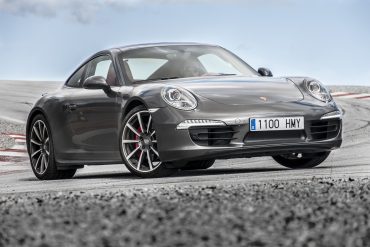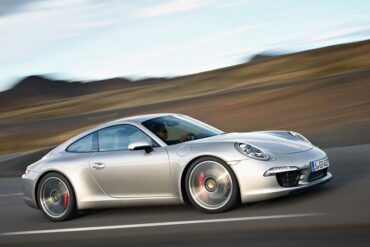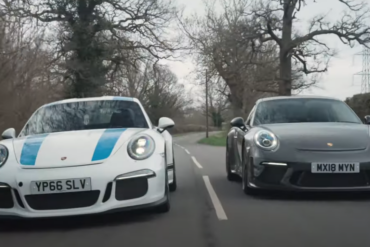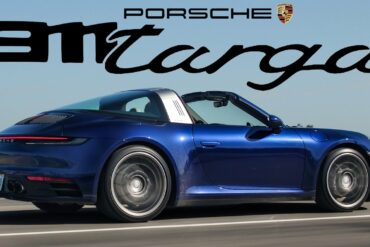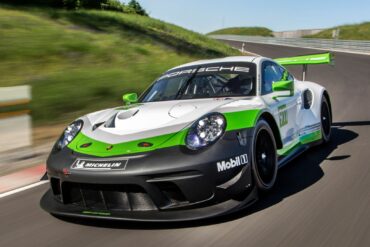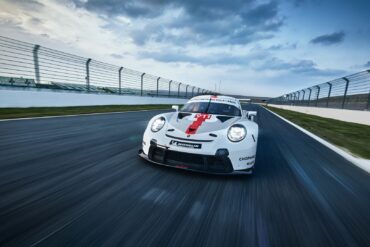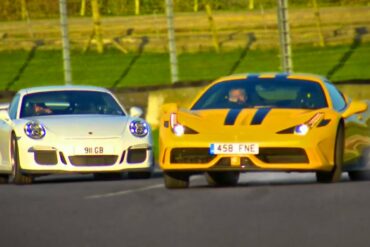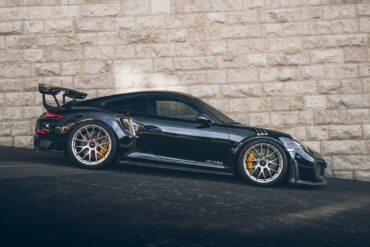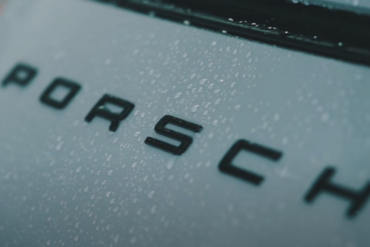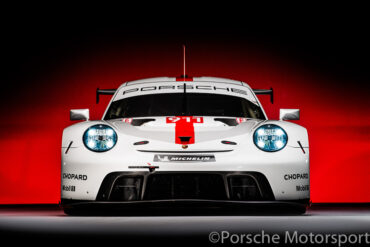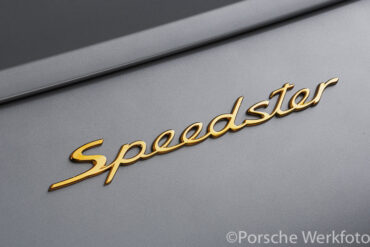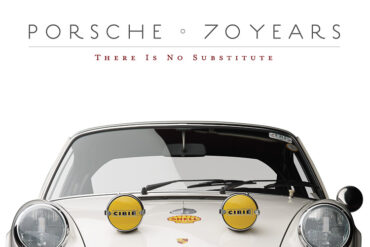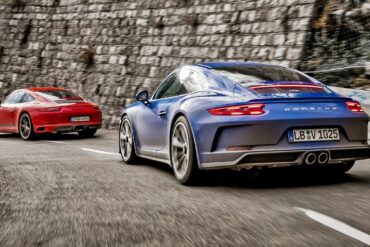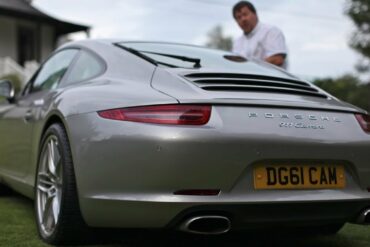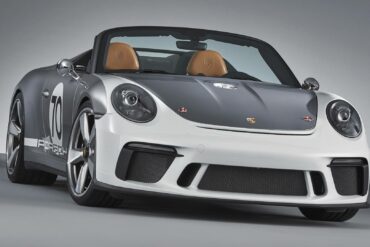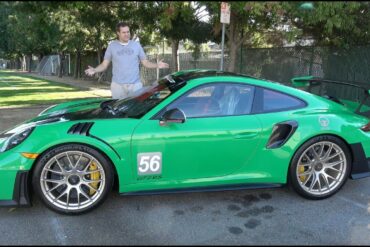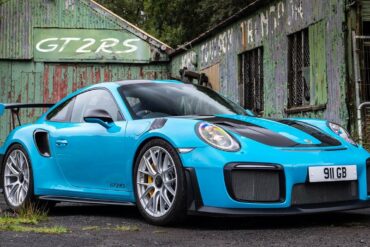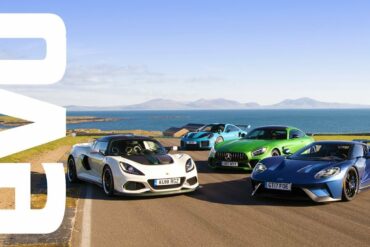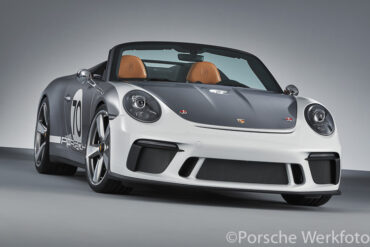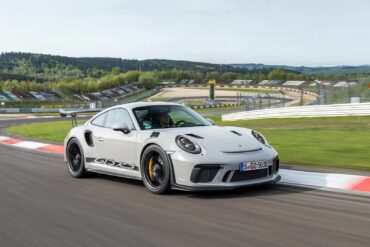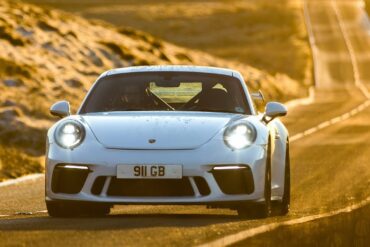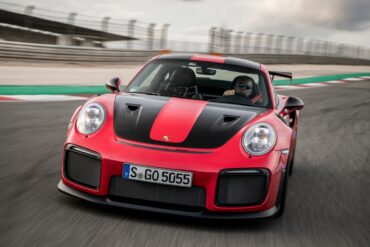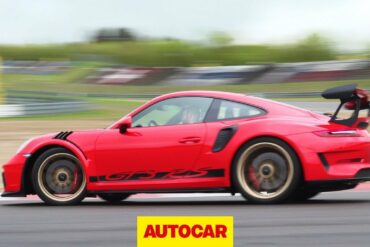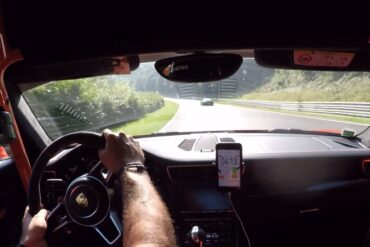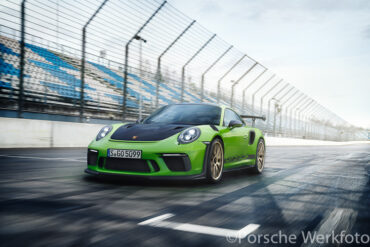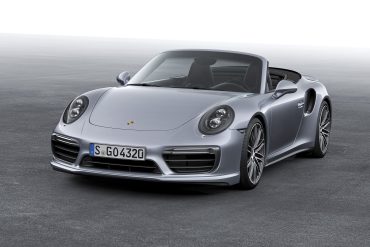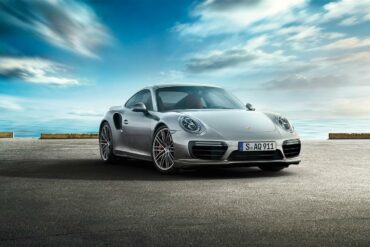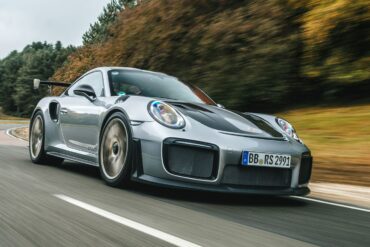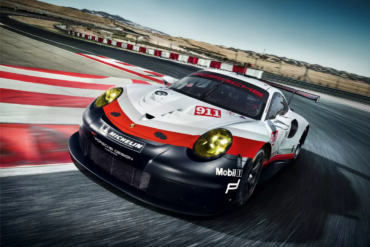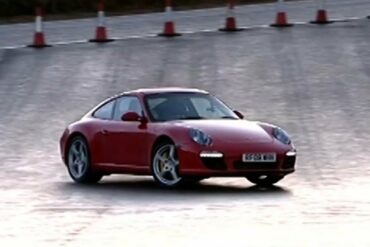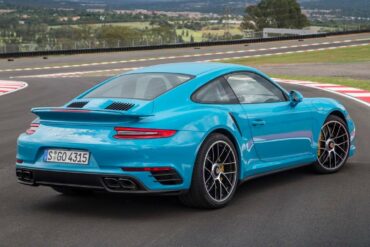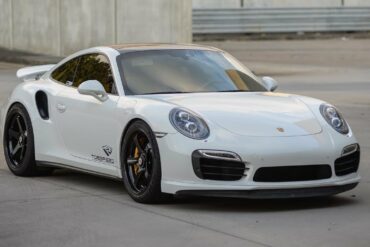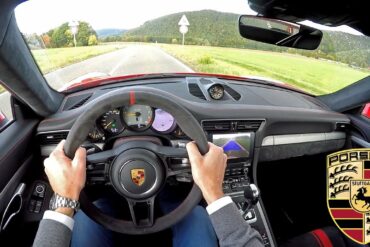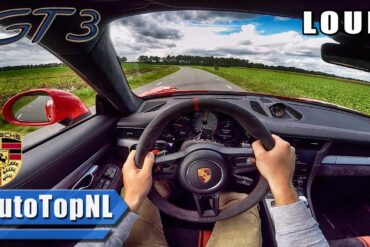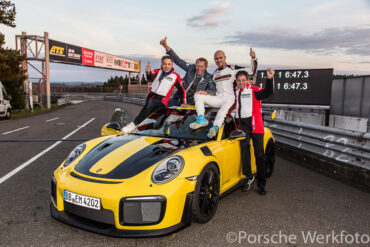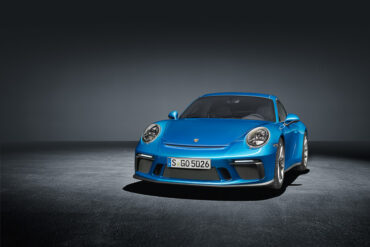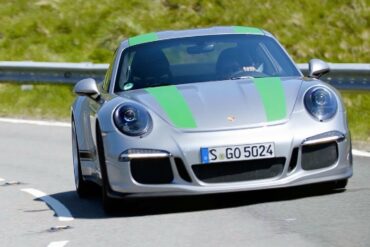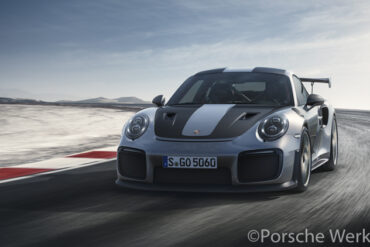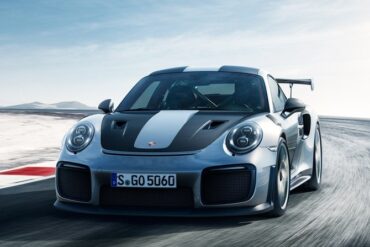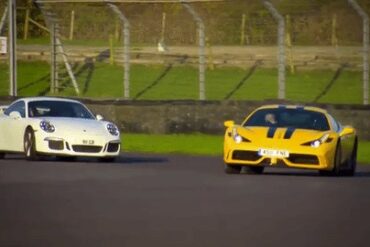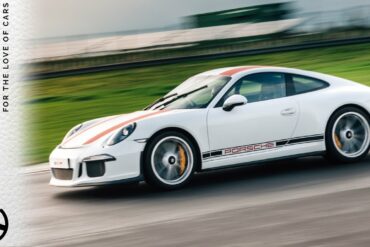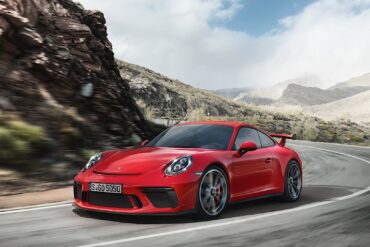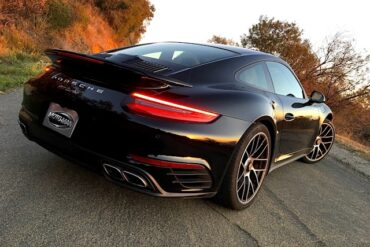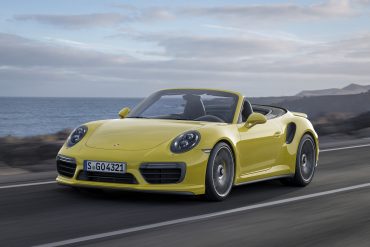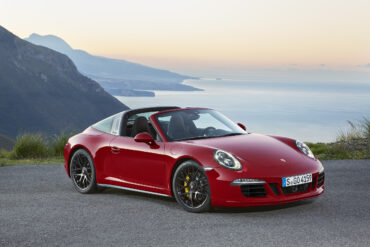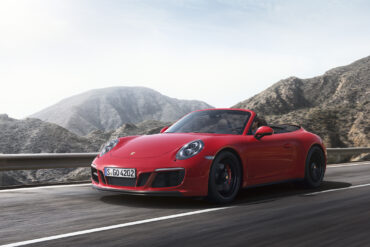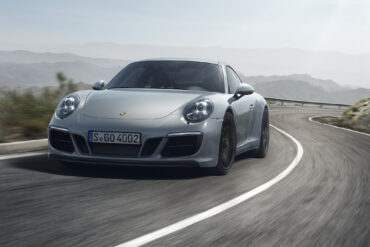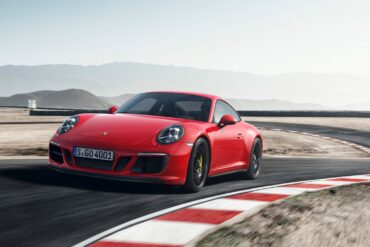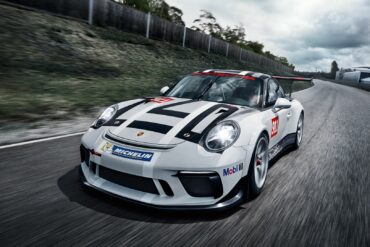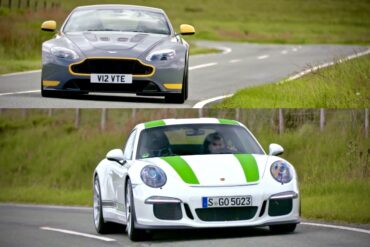Porsche 911 Sales Brochures (Type 991) We found quite a few Porsche sales brochures for the Type 991 911 generation....
Porsche 911 (991)
The Type 991 911 series was the seventh generation of the iconic 911. The 991 generation models were unmistakably 911 in looks and design philosophy, but the 991 was really the ultimate evolution of Porsche 911s becoming highly technical, high quality and well built machines. Quality improved and the technology jump finally vaulted Porsche to the top of the automakers in terms of building the best cars on the planet. The Type 991 represented the most technically advanced 911 model to date and the 991 looked more powerful than any other 911 before – an effect that was heightened by the wider track and a stretched wheelbase. It also featured adaptive aerodynamics: the 911 was the first series sports car from Porsche to adopt this technology from the 918 Spyder hybrid super sports car. The 991.1 generation cars launched as MY 2012 cars. The 345hp 3.4 liter Carrera and 400hp 3.8 liter Carrera S launched first, in both Coupe and Cabriolet bodystyles and could be had with either rear and all-wheel drive drivetrains. The 991s all got electric power steering which took away some of the feel we were used to. The Carrera S got PASM standard (optional on the Carrera). The new Turbo (in coupe and cabriolet) came out in 2013, now with a whopping 512hp. See all of our Porsche 991 Research.
Porsche 911 Spare Parts Catalogs (991, 2012 – 2019 Model Year) These official Porsche PET Diagrams and codes for the...
Porsche Option Codes – Porsche 911 (2019 Model Year) Looking to decode your 2019 Porsche 911 option codes? Want to...
Porsche Option Codes – Porsche 911 (2018 Model Year) Looking to decode your 2018 Porsche 911 option codes? Want to...
Porsche Option Codes – Porsche 911 (2017 Model Year) Looking to decode your 2017 Porsche 911 option codes? Want to...
Porsche Option Codes – Porsche 911 (2016 Model Year) Looking to decode your 2016 Porsche 911 option codes? Want to...
Porsche Option Codes – Porsche 911 (2015 Model Year) Looking to decode your 2015 Porsche 911 option codes? Want to...
Porsche Option Codes – Porsche 911 (2014 Model Year) Looking to decode your 2014 Porsche 911 option codes? Want to...
Porsche Option Codes – Porsche 911 (2013 Model Year) Looking to decode your 2013 Porsche 911 option codes? Want to...
Porsche Option Codes – Porsche 911 (2012 Model Year) Looking to decode your 2012 Porsche 911 option codes? Want to...
Two Amazing Choice – The Porsche 911 R & 911 GT3 Touring The 911 R is one of the rarest...
Porsche 911 Turbo S 992 v 991 Head To Head It’s the one you Porsche fanboys have been waiting for...
2021 Porsche 911 Targa Review 2021 Porsche 911 Targa review by The Straight Pipes. The 992 Porsche 911 Targa is...
Ultimate Track Test Introducing the ULTIMATE 911 – the Porsche 911 GT2 RS! When it comes to road-going sports cars,...
The GT3 R has always been placed between the GT3 Cup and the very expensive RSR. All the 991.2 racing cars have normally aspirated 4-litre engines. Compared to the 991.1 GT3 R, the 991.2 GT3 R engine offers a broader usable rev range and the engine response is more precise due to 6 throttle butterflies. The roof, front hood and fairing, wheel arches, doors, side and tail sections, rear lid and interior trim are made of carbon-fibre reinforced plastic. Gets new double wishbone suspension.
This was the fourth version of the 991 RSR - the first two came with the rear engine, then the first mid-engine version was launched (all 4.0-litre) and finally the mid-engined RSR 4.2 with the largest 911 engine ever made. The increase in the engine capacity is a question mark as on production models the capacities are decreased and turbochargers are used. The 991 RSR 4.2 didn't have anything in common with the production cars anymore. No change in terms of power-to-weight ratio.
Fifth Gear Ultimate Car Showdown Ferrari’s brilliant 458 Speciale takes on the 991 Porsche 911 GT3, with two of our...
The Porsche 911 GTS (991.1) Review Jason continues his quest to find the best modern Porsche 911 for all occasions....
Porsche 991.2 GT3 RS – Turn Up the Volume Unbelievable once-in-a-lifetime DRIVE & SOUND with the recent 2018/2019 Porsche 991.2...
991.2 GT2 RS – Most Powerful 911 Driven Porsche‘s Most Powerful 911 ever!! The Legendary GT2 RS! When a 911 Turbo...
Reviewing The Purist Porsche We go for a drive in the 2018 Porsche 911 Carrera T Manual and PDK....
Porsche 911 Carrera T In Depth We review the last model year of the 991.2 Porsche 911 Carrera T. The...
Tuned 911 Turbo S On the Road I am a big fan of the Cars With Luke channel and in...
My Friend Bought A Stealth Porsche GT2 RS Weissach!! In this weeks episode I take my friends new 991.2 GT2...
The new Porsche 911 RSR (2019) What better way to introduce a new race car model, than to do so...
Porsche 991 GT3 RS on road and track Looks like a 911, drives like a hypercar? The Porsche 911 GT2...
Make no mistake that the Speedster is an absolutely fitting conclusion to the 991-generation. The Porsche 911 Speedster is an ingenious amalgamation of the latest technologies on offer, and the more simple ingredients that have been a principle of driving enjoyment since the invention of automobiles. A 502-horsepower engine, without turbochargers. A modern transmission, with just one clutch. A state-of-the-art suspension and chassis, with an unsullied purity. The list goes on. Perhaps the only drawback is that the Speedster’s rarity and price.
The Porsche 911 GT2 RS MR | Chris Harris Drives The Porsche 911 GT2 RS Manthey Racing has a long...
2019 model Porsche 911 Speedster Last week, at the New York International Auto Show, the iconic new 911 Speedster was...
Porsche 70 Years – There Is No Substitute: by Randy Leffingwell © Quarto Publishing It’s a heavyweight book, landscape in...
Comparing The Analogue Porsches A clash of the analogue Porsches? It’s a David vs Goliath battle of retro-flavoured 911s as...
The Base 991 Carrera Video Review If you want to buy a new 911 now, you’d better be prepared to...
991.2 Porsche 911 GT3 RS Review We go for a drive in the 2018 Porsche 911 GT3 RS. And we...
Porsche is celebrating their 70 years in the making with the Porsche 911 Speedster Concept car. With the Carrera Cabriolet 4 body as its canvas, the Speedster concept pays homage to its predecessors - most notably, the Porsche 356 1500 Speedster. The limited production Speedster is immediately distinguishable from the current 911 line-up, with its “double bubble” tonneau cover and other unique offerings and design tweaks.
Porsche 911 GT3 (991.2) Manual Fun On this Special episode James and Thomas take a spin in the legendary Porsche...
Doug Demuro and the 991.2 GT2 RS The 2018 Porsche 911 GT2RS is the craziest Porsche 911 of all time....
A Proper Road Review of the 991.2 GT2 Rs Henry Catchpole gives the Porsche 911 GT2 RS (991.2) a proper...
Porsche GT2 RS vs Lamborghini Aventador S! The title says it all. Just two friends drag racing two amazing cars...
Ultimate Track Test Road Racers. Ford GT, Porsche 911 GT2 RS, AMG GT R and Lotus Exige Cup 430 –...
Salon Privé, Blenheim Palace, 1 September 2018: Concours Masters Celebration of 70 Years of Porsche I received the email inviting...
991.2 Carrera GTS Review I reflect on another amazing year at Monterey Car Week with the 2018 Porsche 911 GTS....
Head to Head Mercedes-AMG GT C vs Porsche 911 Carrera T For the road, the GT C is the best...
Born on 8 June 1948, the Porsche 356 No.1 was presented to the world, immediately setting standards by which the...
Matt Prior from Autocar nails the 991.2 GT3 RS: “While I don’t think the 3 communicates any better than a 2, the messages it does transmit are superior: you can feel that it’s lighter, more willing to turn, easier and more satisfying to ease onto the throttle and keep it pinned. It’s why this car is only a few seconds slower than a 2RS around the Nürburgring Nordschleife despite being almost 200bhp down.” He goes on... “And in the form of the GT3 RS it goes into creating - little by little, detail by detail - what might just be the best driver’s car currently on sale.”
Carfection Road Test of the New 991.2 GT3 Henry Catchpole gives the Porsche 991.2 911 GT3 a full road review...
We Pick A Winner We get to take the new Porsche 911 GT2 RS and Lamborghini Aventador S for a...
Carfection Makes The Case for the Manual Henry Catchpole demonstrates why the manual is something to be treasured in a...
The GT2 RS's reputation as the most powerful street-legal car is as monstrous as this comprehensive guide. Suffice to say, this supercar has been built with the best Porsche has to offer. It's not bragging, it's just facts. There is no doubt that the new GT2 RS is the pinnacle of the 911 in terms of performance. It is simply the fastest 911 in history, and that’s a fact. It is the quickest production car to lap the Nürburgring Nordschleife. It is the most powerful 911 ever made.
On Track With Porsche’s Best 2018 Porsche GT2 RS, Porsche GT3, Porsche 911T, 718 Cayman GTS, and 718 Boxster GTS....
Henry Catchpole drives the 991.2 Porsche 911 GT3 RS in search of the forgotten Sudschleife circuit....
The 500 hundred numbered 911 Turbo S Exclusive Series cars cross the 600 hp mark with their 446 kW engines. The power increase does not make much difference performance wise, but it is good to know you have more than 600 hp. Similar in acceleration and top speed to the ‘regular’ Turbo S, the car reaches 200 km/h (124 mph) in 9.6 seconds (0.3 seconds faster than the regular Turbo S). The car comes standard with the Turbo Aerokit and roof panel made of carbon-fibre reinforced plastic.
To the untrained eye, the Carrera T may appear to be a bare-bones and sparingly equipped 911 at first glance. The purpose of the T is to create a driver-focused 911, equipped with only the necessities required to appeal to those of a purist’s ilk. The Carrera T employs the same power plant used in the current base Carrera - a twin-turbocharged 3.0L flat-six with 370 horsepower and 331 lb-ft of torque. A 7-speed manual transmission comes standard with the T, along with a shorter final-drive ratio and the limited-slip differential. Porsche Sport Exhaust (PSE) is also standard. PASM sport suspension comes standard in the T, which lowers the chassis by 0.4 inches relative to the base Carrera and allows for two modes of dampening.
A Thorough Review of the 991.2 GT3 RS The 991.2 GT3 Rs comes with a power upgrade to the 911...
Porsche 991 GT3 RS Morning Drive Put your headphones on and enjoy this awesome footage of a Porsche 991...
Quick race on a half Nurburgring lap, the Mercedes-AMG GTR was on the rear from the beginning and Porsche 991...
2018 Porsche 911 GT3 RS With a clear focus on motorsport, the Porsche Motorsport department will present its latest project...
Porsche 911 Carrera T Video Review In the Porsche 911 Carrera T Henry Catchpole revels in the delights of no...
The Cabriolet version of the 991.2 Turbo got the same updates as its coupe sibling. The engine in the 991.2 911 Turbo Cabriolet is a twin-turbocharged flat-six with 540 horsepower and 523 pound-feet of torque, up a decent 20 more horses versus the 991.1 Turbo Cab. Improvements that come from increases in boost and fuel-injection pressures. Rounding the skidpad, the Turbo posts 1.02 g’s relatively easily. The wide P Zeros in back and the standard four-wheel steering conspire to hide the fact that 62 percent of the Turbo’s 3656 pounds sits over the rear wheels. 0 - 60 mph is over in just 3 seconds.
At the heart of the 991.2 911 Turbo is a twin-turbocharged flat-six with 540 horsepower and 523 pound-feet of torque. That’s a meaningful 20 more horses than the 991.1 Turbo. Improvements that come from increases in boost and fuel-injection pressures. Rounding the skidpad, the Turbo posts 1.02 g’s relatively easily. The wide P Zeros in back and the standard four-wheel steering conspire to hide the fact that 62 percent of the Turbo’s 3656 pounds sits over the rear wheels. With sport-plus selected, the 991.2 Turbo hits a 1.0-second run to 30 mph and a 2.6-second zero-to-60 time.
991.2 GT2 RS Reviewed CAR magazine UK reviews the new 2018 Porsche 911 GT2 RS – the 690bhp, rear-wheel drive...
This car was officially called as the 911 GT2 RS Clubsport, but the name is rather misleading. The car was not built for the GT2 racing class which is long extinct and club sport has stood for Porsche club track days while this non-streel-legal car is a real racing car. Finally, the car was based on the 991 GT2 RS, which already had the Clubsport version. So, in order to understand what is what, we call it "991 GT2 RS Clubsport racing version". The 991 GT2 RS engine with 515 kW was powerful enough, so it was not tuned.
Two decades after the different 911 GT1 cars the mid-engined 911 is back! In order to install a proper diffuser under the rear end of the 991, the engine had to make room for it and the engine/transmission unit was rotated 180 degrees. The extended rear diffuser, a top-suspended rear wing and the new side mirrors help to increase downforce with reduced drag. The FIA rules meant no turbo was needed due to power limits, so the normally aspirated 4-litre flat-6 was taken from the 991 GT3 R.
Tiff’s Quick Take On The Porsche 911 Carrera S Throwback Thursday clip from series 15 of Tiff reviewing the 991...
Porsche 991.2 Turbo S Review The Porsche 991.2 Turbo S may be the world’s most well rounded car. It squeezes...
991.2 GT2 RS – Most Powerful 911 Driven The Porsche 911 GT2 RS, then. Take a Porsche 911, add a...
One Take In An Aftermarket Turbo S This video was filmed at #GRIDLIFE Motorsports and Music Festival South, Road Atlanta....
Porsche is the most successful marque in the 24 Hours of Le Mans and British drivers have played an important role in delivering these historical achievements, and in celebration of this success a special limited edition model – the 911 Carrera 4 GTS British Legends Edition was created. Designed by the drivers who took wins in the 24 Hours of Le Mans for the factory team – Richard Attwood (winner 1970), Derek Bell MBE (winner 1981, 1982, 1986, 1987) and Nick Tandy (winner 2015) – this model was developed by Porsche Cars GB and Porsche Exclusive Manufaktur.
Mountain Run in a 991.2 GT3 In this video I take you for a POV test drive behind the wheel...
991.2 911 GT3 POV Driving Impressions Porsche 911 GT3 (991.2) POV Test Drive INSANE SOUND!! by AutoTopNL...
The 911 GT3 with Touring Package was unveiled yesterday at the 67th International Motor Show (IAA) in Frankfurt, Germany. Available...
Drivers Cars & What Makes Them So Special Chris Harris compares and contrasts the Porsche 911R and the Peugeot 205...
The Porsche 911 GT3 | Chris Harris Drives | Top Gear In this week’s instalment, Chris Harris tackles the mighty...
The new Porsche 911 GT2 RS, the most powerful road-approved 911 of all time, celebrated its world premiere at the...
Top Speed In a Porsche 911 GTS German correspondent Thomas Hellmanzik gets his first 911 driving experience, and promptly hits...
New 2018 911 GT2 RS with 700 hp, rear-wheel drive, race-bred chassis, and rear axle steering Atlanta, Georgia. The fastest and...
Introduced in June 2017, the new 911 Turbo S Exclusive Series is the most powerful all-wheel drive turbocharged member of...
This video shows a head to head battle between the two of the best cars on the market today: the 458...
New Porsche 911 GT3 2017 Thorough review of the 991.2 Porsche 991 GT3. As well as being the fastest and...
Hardcore new GT3 Tested by Autocar The Porsche 911 GT3 is back. The revised 991.2 GT3 is a stripped-out, track-ready,...
2018 Porsche 911 GT3 Track Review Porsche have listened to their customers and added all the lessons they’ve learned recently...
991 Porsche 911 R Review The Porsche 911 R is more than its figures, much, much more than that. Carfection...
991 Carrera 4S v Carrera 2S Track Battle C2S vs C4S or C2 vs C4 is the question. I take...
The new Porsche 911 GT3 carries the same four-litre flat engine from the GT3 RS with its power increased by 25hp for a new total of 500hp. The chassis is also redesigned and now features a rear-axle steering and a lighter construction. The Porsche 911 GT3 type 991.2 comes in at 1,430 kg when its tank is full. Although it is a bit heavier than the previous model, it still manages to reach 0-100km/h in just 3.4 seconds and reach top speeds of 318km/h. What’s more interesting here is that Porsche finally decided to switch back to a 6-speed manual gearbox (7-speed PDK is standard).
MotoManTV Review of the 991.2 Turbo After fitting all base 991s with turbos, Porsche has gone through and updated the...
With the Turbo S, the PDCC Porsche Dynamic Chassis Control hydraulic roll bars came as standard. The PCCB Porsche Ceramic Composite Brakes had been standard on the Turbo S already since the 996 generation. New options included the radar-based lane change assist and a lift system for the front axle (increased ground clearance by 1.6″/40 mm). The PCM now had a multi-touch screen like in the facelifted 991 Carrera. Routes and places could be visualized with 360-degree images and satellite images. Engine gets more horsepower too, now with 572 bhp and 553 ft lbs of torque.
This is the fastest convertible GT you can buy. The Turbo S cab gets 572 bhp (39 hp more than the base turbo cab) and 553 ft lbs (9 ft lbs more than the regular cab) of torque. With the Turbo S, the PDCC Porsche Dynamic Chassis Control hydraulic roll bars came as standard. The PCCB Porsche Ceramic Composite Brakes had been standard on the Turbo S already since the 996 generation. New options included the radar-based lane change assist and a lift system for the front axle (increased ground clearance by 1.6″/40 mm). The PCM now had a multi-touch screen like in the facelifted 991 Carrera.
991.2 Porsche 911 Targa 4 GTS Review The 991.2 generation of Porsche 911 has been given the GTS treatment and...
The 911 Targa 4 GTS isn't the fastest or best performing 911. It is heavier, softer and not as fast as every other GTS model. But we still love it. The Targa 4 GTS has amazing performance coupled with the sexiest body in the business. In GTS trim the Targa body looks even better. This is the car you get when you can only choose one 911 and you need it for fun weekends, daily driving and taking the wife out to a fancy restaurant. With 450 hp and 405 lb-ft from 2150 to 5000 rpm, it also has more than enough street performance than you could ever need. Buy one.
The GTS 4 Cabriolet reminds us how awesome Porsche cars are. This is a 911 that can be used as a regular car, an all weather convertible 911 that does everything really well. And when you want to push hard, the car transforms into a true sports car, a car that no enthusiast will ever complain about. Drop-top 911s have always played a supporting role to the fixed roof versions, but in GTS specification the Cabriolet is now better than ever.
Ultimately, the Carrera 4 GTS is the ideal all-round 911. Its bag of tricks gives you accessible, astonishing performance on the right road – but its price tag and comfort levels make it a little more acceptable for everyday use than a GT2, GT3 or Turbo. The GTS scores particularly well on the practicality to performance ratio. Its rear seats can accommodate people and its all-wheel drive system means you can really use this car all-year round. The GTS-spec 3.0-litre flat-six develops 30bhp more than a Carrera S (at 444bhp) and 37lb ft more torque (at 406lb ft).
Porsche really has hit its brief with the turbocharged Carrera GTS Cabriolet. It is hugely capable on the road, easy to live with on a daily basis, and come the weekend, it’s massively fast on track. For the money, and for drivers who really want just a little more 911, but without the mind-bending speed of a Turbo or uncompromising nature of a GT3, then this is the car for you. It also looks unique and has enough of its own style that it it feels special both on the outside and inside.
The GTS coupe starts with the wider Carrera 4 body, with the rear fenders pushed out 1.7 inches, and the rear track widened 1.6in. Up front is the new SportDesign front fascia with its lower front spoiler and larger cooling air intakes. Standard wheels are 20-inch center lock items and 0.5 inch wider than standard Carrera S rims, finished in satin black. There are splashes of black elsewhere, too. The changes run more than skin deep. Bigger turbos pump up to 18psi of boost pressure which helps deliver not only 30 extra horses at 6,500 rpm, but 405 lb-ft of torque between 2,150 rpm and 5,000 rpm, up from 368 lb-ft. This is the sweet spot.
The rear of the world’s most-produced GT racing car now houses a 4-litre, six-cylinder flat engine for even more drive. Thanks to thoroughbred motorsport technology, the compact engine with direct fuel injection delivers peak performance of 357 kW (485 hp). A range of innovative details also improve efficiency in addition to engine performance, ensuring even better durability of the naturally aspirated engine in racing mode and reduced maintenance costs.
Porsche 911 Turbo S 991 MK2 AUTOBAHN POV Porsche 911 Turbo S 991 MK2 AUTOBAHN POV 295km/h by AutoTopNL...
Porsche 911 R Reviewed Porsche 911 R – With one Top Gear test track and one rear-wheel-drive, naturally-aspirated, 493bhp manual...
The Porsche 911 R On Track The phenomenal Porsche 911 R stars in our penultimate video from Britain’s Best Driver’s...
Aston V12 Vantage S Vs Porsche 911 R The Porsche 911 R has 493bhp from a 4-litre naturally aspirated flat-six...



